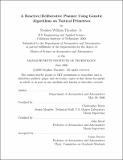| dc.contributor.advisor | Christopher Dever and John Deyst. | en_US |
| dc.contributor.author | Thrasher, Stephen William | en_US |
| dc.contributor.other | Massachusetts Institute of Technology. Dept. of Aeronautics and Astronautics. | en_US |
| dc.date.accessioned | 2007-02-20T15:07:36Z | |
| dc.date.available | 2007-02-20T15:07:36Z | |
| dc.date.copyright | 2006 | en_US |
| dc.date.issued | 2006 | en_US |
| dc.identifier.uri | http://hdl.handle.net/1721.1/35921 | |
| dc.description | Thesis (S.M.)--Massachusetts Institute of Technology, Dept. of Aeronautics and Astronautics, 2006. | en_US |
| dc.description | This electronic version was submitted by the student author. The certified thesis is available in the Institute Archives and Special Collections. | en_US |
| dc.description | Includes bibliographical references (p. 99-102). | en_US |
| dc.description.abstract | Unmanned aerial systems are increasingly assisting and replacing humans on so-called dull, dirty, and dangerous missions. In the future such systems will require higher levels of autonomy to effectively use their agile maneuvering capabilities and high-performance weapons and sensors in rapidly evolving, limited-communication combat situations. Most existing vehicle planning methods perform poorly on such realistic scenarios because they do not consider both continuous nonlinear system dynamics and discrete actions and choices. This thesis proposes a flexible framework for forming dynamically realistic, hybrid system plans composed of parametrized tactical primitives using genetic algorithms, which implicitly accommodate hybrid dynamics through a nonlinear fitness function. The framework combines deliberative planning with specially chosen tactical primitives to react to fast changes in the environment, such as pop-up threats. Tactical primitives encapsulate continuous and discrete elements together, using discrete switchings to define the primitive type and both discrete and continuous parameters to capture stylistic variations. This thesis demonstrates the combined reactive/deliberative framework on a problem involving two-dimensional navigation through a field of threats while firing weapons and deploying countermeasures. It also explores the planner's performance with respect to computational resources, problem dimensionality, primitive design, and planner initialization. These explorations can guide further algorithm design and future autonomous tactics research. | en_US |
| dc.description.statementofresponsibility | by Stephen William Thrasher, Jr. | en_US |
| dc.format.extent | 102 p. | en_US |
| dc.language.iso | eng | en_US |
| dc.publisher | Massachusetts Institute of Technology | en_US |
| dc.rights | M.I.T. theses are protected by copyright. They may be viewed from this source for any purpose, but reproduction or distribution in any format is prohibited without written permission. See provided URL for inquiries about permission. | en_US |
| dc.rights.uri | http://dspace.mit.edu/handle/1721.1/7582 | |
| dc.subject | Aeronautics and Astronautics. | en_US |
| dc.title | A reactive/deliberative planner using genetic algorithms on tactical primitives | en_US |
| dc.type | Thesis | en_US |
| dc.description.degree | S.M. | en_US |
| dc.contributor.department | Massachusetts Institute of Technology. Department of Aeronautics and Astronautics | |
| dc.identifier.oclc | 77536235 | en_US |

